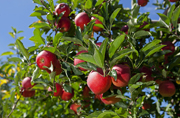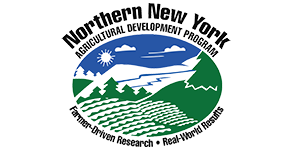
Peru, N.Y.; September 12, 2019. Apple research funded by the farmer-driven Northern New York Agricultural Development Program and conducted by Srdjan G. Acimovic, Ph.D., of the Hudson Valley Research Laboratory, has helped regional growers recover from the 2016 epidemic of fire blight in the Champlain Valley region, and the project data has informed growers statewide.
“The impact of this research is depicted in the fact that growers did not have any new fire blight epidemics in 2017 or 2018 in the same or nearby orchards nor any new tree or fruit losses,” said Acimovic, a Senior Extension Associate in the Cornell University School of Integrative Plant Science Plant Pathology and Plant-Microbe Biology Section, based at the Hudson Valley Research Laboratory, Highland, N.Y.
Fire blight is a bacterial disease that infects apple flowers, shoots and, sometimes, entire trees, with the potential to cause severe economic damage to orchard businesses.
Cornell researchers estimate the damage, including yield loss and tree death, from a fire blight epidemic in the northern NY apple orchards in 2016 at more than $14 million.
Seven NNY apple farms and one Hudson Valley apple grower have worked with Acimovic as his research team refines the development of fire blight detection and prediction tools and associated management recommendations.
The detection of the fire blight pathogen in rootstocks in the NNY orchards helped growers identify infected trees for removal, and, in some cases, which orchard blocks needed replanting after the 2016 epidemic.
“A year ago, in September 2018, when we rated trees in the NNY apple orchards for tree death caused by fire blight, we detected very little change in six of the seven farms and only slightly more dead trees on one farm,” Acimovic noted.
On-farm monitoring, location-specific fire blight prediction interpretation, and e-mail alerts with management recommendations have kept growers ahead of the disease curve, encouraged precision application, and, therefore, reduced spraying.
The NNY orchard owners allowed Acimovic to use their data to support alerts to growers statewide.
However, Acimovic advises caution as the fire blight pathogen can linger at low levels beyond the detection of current tools. He has worked with NNY growers in 2019 to enhance the sensitivity of the detection equipment.
The current precision apple orchard research funded by the Northern New York Agricultural Development Program is also developing a more in-depth understanding of the strains of fire blight bacterium to learn their virulence and ability to infect orchards not only in NNY, but anywhere in New York State.
“Characterizing the various strains of fire blight will inform us more about the susceptibility or resistance an orchard may have, and how well it might respond to treatment,” Acimovic said.
The NNYADP-funded apple research in 2019 is applying new apple disease prediction models to time and reduce spraying, measuring the efficacy of copper applications to manage fire blight, and analyzing the dynamics of the pathogen development in tree cankers over the two years of data collected in the NNY orchards.
Apple growers interested in more information on this research may contact Cornell Cooperative Extension Tree Fruit Specialist Michael Basedow at 518-410-6823. The Northern New York Agricultural Development Program website at www.nnyagdev.org includes a link to the Acimovic Lab disease management and modeling blog.
 Funding for the Northern New York Agricultural Development Program is supported by the New York State Legislature and administered by the New York State Department of Agriculture and Markets.
Funding for the Northern New York Agricultural Development Program is supported by the New York State Legislature and administered by the New York State Department of Agriculture and Markets.
Click here for the complete NNYADP fire blight research report